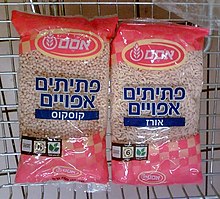Israeli couscous
 | |||||||
| Alternative names | Israeli couscous | ||||||
|---|---|---|---|---|---|---|---|
| Type | Pasta | ||||||
| Course | Side dish | ||||||
| Created by | Osem | ||||||
| Main ingredients | Wheat | ||||||
| 200 kcal (837 kJ)[1] | |||||||
| |||||||
Ptitim (Hebrew: פְּתִיתִים, p'titím, lit. 'flakes', singular: פְּתִית, p'tít, lit. 'flake')[2] – sometimes called pearl couscous – is toasted pasta in tiny balls. Despite its name, it is not a type of couscous (Hebrew: קוּסְקוּס, kus'kus).
History
[edit]
Ptitim was created in 1953,[3] during the austerity period in Israel.[4]
Israel's first prime minister, David Ben-Gurion, asked Eugen Proper, one of the founders of the Osem food company, to devise a wheat-based substitute for rice.[5] The company took up the challenge and developed ptitim, which is made of hard wheat flour and toasted in an oven. Ptitim was initially produced with a rice-shape, but after its success Osem also began to produce a ball-shaped variety inspired by couscous.[6]
Consequently, ptitim is sometimes called "Ben-Gurion rice".[7]
Preparation
[edit]Ptitim is made by extruding dough through a round mold, before it is cut and toasted, giving it the uniform natural-grain-like shape[6] and its unique nutty flavor.[8] Unlike common types of pasta and couscous, ptitim was factory-made from the outset, and therefore is rarely seen home-made from scratch. The store-bought product is easy and quick to prepare.[9]
In Israel, ptitim is popular among children, who eat it plain, or mixed with fried onion and tomato paste.[5] Ptitim is now produced in ring, star, and heart shapes for added appeal.[7] Varieties made with whole wheat and spelt flour are also available for health-conscious consumers.[10][5] Ptitim has also been popularised in other countries,[7] and in the United States, it can be found on the menus of contemporary American chefs and in gourmet markets.[11]


Ptitim can be used in many different types of dishes, both hot and cold.[9] The grains retain their shape and texture even when reheated, and they do not clump together.[11] Commonly, ptitim is prepared with sautéed onions or garlic (vegetables, meat, chicken or sausage can also be added). The ptitim grains may be fried for a short time before adding water.[7] They can also be baked, go in soup, served in a pie, used for stuffing, or made as a risotto.[5] Ptitim may also be used in other dishes as a substitute for pasta or rice.[12] American chef Charlie Trotter has produced a number of recipes for ptitim-based gourmet dishes,[5] even as a dessert.[6]
Similar products
[edit]Ptitim are very similar to the German farfel, which was brought by German Jews from Europe beginning in the 1800s, and the two are often substituted for each other.[13]
The round shape of ptitim is reminiscent of the forms of Levantine 'pearl' couscous that pre-date it, and which are known as moghrabieh in Jordan, Lebanon and Syria, or as maftoul in Palestinian cuisine.[14][4] While moghrabieh and maftoul are produced by rolling dough between the palms or fingers, ptitim are formed by extrusion through a die in the same process as many other pastas,[15] and the two are somewhat different in terms of taste and preparation.[3]
Ptitim are also similar to the Berber berkoukes (aka abazine) and the Sardinian fregula, but these, too, unlike ptitim, are rolled and coated products. Ptitim also resemble some products of the pastina family, in particular acini di pepe, orzo ("risoni") and stellini. However, unlike pastina, the ptitim grains are pre-baked/toasted[14] to give them their chewy texture and nutty flavor.[6]
See also
[edit]References
[edit]- ^ USDA FoodData Central: ORIGINAL Israeli (PEARL) COUSCOUS, ORIGINAL (Branded, 1068523). Access date 2021-01-10. Publish date 2020-08-27
- ^ "Wondering about Israeli Couscous or How to Cook It?". The Spruce Eats.
- ^ a b Crum, Peggy (10 February 2010). "Featured Food: Israeli Couscous" (PDF). Recipe for Health. Residential and Hospitality Services, Michigan State University. Retrieved 7 April 2017.
- ^ a b Marks, Gil (2010). "Couscous". Encyclopedia of Jewish Food. Houghton Mifflin Harcourt. pp. 315–317. ISBN 978-0544186316.
- ^ a b c d e Doram Gaunt (9 May 2008). "Ben-Gurion's Rice". Haaretz.
- ^ a b c d Martinelli, Katherine (3 November 2010). "Ben Gurion's Rice and a Tale of Israeli Invention". Food. The Forward.
- ^ a b c d Gur, Janna (2008). "Simple Pleasures". The Book of New Israeli Food: A Culinary Journey. Schocken Books. p. 127. ISBN 978-0805212242.
- ^ "Stocking Your Fridge and Pantry". What Good Cooks Know: 20 Years of Test Kitchen Expertise in One Essential Handbook. America's Test Kitchen. 2016. p. 134. ISBN 978-1940352664.
- ^ a b Callard, Abby (22 March 2010). "Newly Obsessed With Israeli Couscous". Arts & Culture. Smithsonian. Washington, D.C.
- ^ Sharon Wrobel (6 July 2006). "Half of Israeli households buy low-fat products". The Jerusalem Post.
- ^ a b Faye Levy (5 October 2007). "Petit ptitim". The Jerusalem Post.
- ^ Meador, David (14 October 2015). "Squash provides fantastic fall flavors". Living, Food & Drink: Cooking with Local Chefs. The Bradenton Herald.
- ^ Koenig, Leah. "The Truth About Israeli Couscous". Taste Cooking. Retrieved 4 September 2023.
- ^ a b "Israeli Couscous". GourmetSleuth.com. Archived from the original on 26 June 2012. Retrieved 5 June 2012.
- ^ Koenig, Leah. "The Truth About Israeli Couscous". Taste Cooking. Retrieved 4 September 2023.
External links
[edit]- How to Cook Israeli Couscous
- Israeli Couscous Recipes Archived 2014-07-13 at the Wayback Machine
